



Presented by Satellite Educators Association
And Sponsored by

"SatEdCon XXXII Celebrates 50 Years of Apollo 11 and Women in STEM"
Satellites & Education Conference XXXII –
Speakers • Presenters • Research Posters • Exhibitors • Special Thanks
The 32nd annual Satellites & Education Conference, held August 2-3, 2019 at California State University, Los Angeles, celebrated 50 years of space program achievements since Apollo 11's landing on the Moon and the role of women in STEM careers. "Earth Speaks! We Listen!" is the fundamental theme of the conference -- using satellite technologies to understand, and become better stewards of, our home planet. Teachers of science, mathematics, language arts, geography, engineering, and technology gathered together with aerospace engineers, educators from all levels, representatives from NOAA and NASA, and university researchers to learn from each other and explore rich experiences together. The Conference presented teachers with a program of informative speakers, engaging presentations, and opportunities to network with other educators and exhibitors from government and industry in support every student.

Hildreth (Hal) Walker, Jr. was honored in a special, surprise presentation from the New Jersey State Legislature delivered by John Moore just before the conference closing on Saturday, August 3, 2019. Walker had just returned from a reenactment of Apollo 11's Lunar Laser Ranging Experiment at the Lick Observatory celebrating the experiment's 50th anniversary. The University of California's Lick Observatory is located on Mount Hamilton just east of San Jose, California.
On August 1, 1969, Walker fired a KORAD K-1500 Ruby LASER toward the Moon. Apollo 11 astronauts Buzz Aldrin and Neil Armstrong placed mirrors on the Moon's surface to reflect the LASER beam back to Earth. This Lunar Laser Ranging Experiment accurately measured the distance between the Earth and the Moon. Walker managed the development, testing and operation of the laser ranging system. It is the only one of all Apollo mission experiments still operable today.
On July 24, 2015, Hal Walker delivered the keynote address at the opening of Satellites & Education Conference XXVIII and has been a friend of the conference since. Congratulations, Hal!
Photo source: Hal Walker, Jr.

Monica Maynard received SEA's Vic Everett Service Award at a special presentation by SEA President Mark Mckay on Friday, August 2 at Satellites & Education Conference XXXII. Maynard provides the conference with The Aerospace Corporation's exhibit booth and offers break-out sessions with great ideas for teachers. She is, herself, a public school teacher, and during the summer she works for The Aerospace Corporation as their STEM Coordinator. She has provided workshops for SEA teachers and coordinated service for the conferences. Maynard is pleasant, outgoing, with a positive attitude even when her car broke down on the way to the conference in 2018. When she offers The Aerospace Corporation weekend workshops, she always mentions the Satellites & Education Conference and speaks highly of it. She is always willing to support in every way she can. The Satellite Educators Association is pleased to honor and recognize Monica Maynard for her contributions. Maynard was awarded a special plaque and her name has been added to the perpetual plaque on display at the SEA conference booth. Congratulations, Monica! And Thank You from SEA!
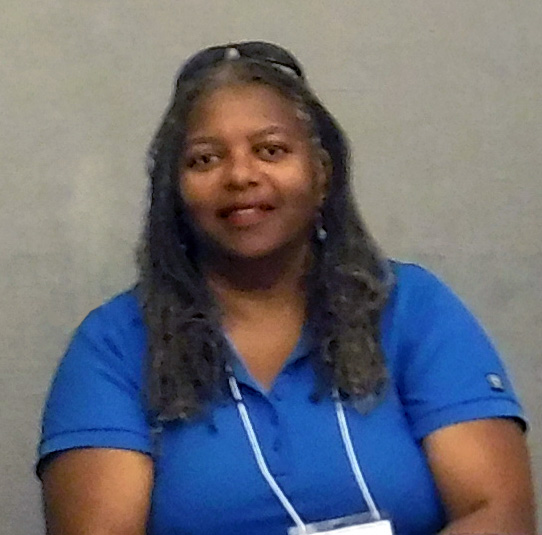
Annie H. Richardson, Public Outreach Specialist at NASA/Jet Propulsion Laboratory, was recognized for excellence in service to the Satellite Educators Association with the Everett Service Award on July 20, 2018 at Satellites & Education Conference XXXI. Since Richardson was unable to attend the conference in 2018, the award was formally presented by SEA President Mark Mckay at the Conference XXXII Banquet on Friday, August 2, 2019. Annie Richardson has been an outspoken supporter of the Satellites & Education Conference and the M.Y. S.P.A.C.E. Program for most of the years the conference has been at Cal State LA. For more than a decade and a half, she has worked tirelessly behind the scenes to arrange tours for M.Y. S.P.A.C.E. teams (including gathering all necessary documentation for security checks prior to the conference), and constructing the tours to meet the research needs of each team. Richardson has been responsible for recruiting some of the most dynamic and informative keynote speakers for the Satellites & Education Conference. When you see the NASA/JPL exhibit booth at the conference, you will find Annie Richardson, a hearty advocate of STEM education. Thank You, and Congratulations to Annie!
Photo credits: Satellite Educators Association
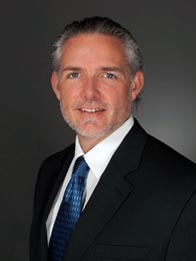
As Director of Engineering Learning and University Relations at Raytheon Space and Airborne Systems, Mr. Ellis shared his thoughts on how industry can partner with educators to provide project-based learning and mentoring opportunities for students of all ages. Using his own experiences as an "accidental engineer," he discussed how growing up without STEM-specific role models influenced his early academic choices and how project-based learning -- outside of the classroom -- helped him find a career in engineering.
Noel Ellis has over 30 years of experience working in a variety of engineering and entrepreneurial endeavors. He is currently responsible for Engineering Continuing Education, Organizational Training, as well as a number of Talent Development programs at Raytheon Space and Airborne Systems (SAS). He also leads Engineering University Relations and manages the SAS University Research portfolio. Mr. Ellis served as Raytheon’s Professor of Practice and Cal Poly San Luis Obispo from 2012-2013 and is a leader and spokesperson for STEM. He participates regularly in community outreach events to increase awareness of STEM career opportunities among middle and high school students. He will also draw on his now more than 15 years of experience in STEM outreach to identify how industry can help close those gaps for all students; and how industry can find value in doing so.
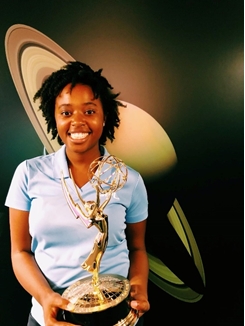
Janelle Wellons graduated from the Massachusetts Institute Technology with a Bachelor of Science degree in Aerospace Engineering. After graduating, she began work at the NASA Jet Propulsion Laboratory as an instrument operations engineer. She currently works on the Lunar Reconnaissance Orbiter, the earth-observing Multi-Angle Imager for Aerosols (MAIA), and previously on the Saturnian Cassini mission. Her job consists of creating the commands for and monitoring the health and safety of a variety of instruments. She also works in development, specifically for the ground data system and instrument operations concepts for the MAIA mission. When she isn’t working you can find her playing video games, reading, enjoying the outdoors, and doing outreach. Wellons described her unexpected journey from high school to a "dream job" with abundant enthusiasm and excitement. She encourages all young people to do their best and believe in their own abilities to discover the possible.
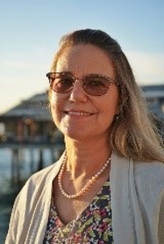
Laurel Gutierrez is the Space Systems Chief Architect as well as Chief Engineer for Civil, Commercial and International Space Product Area at Raytheon. Gutierrez has over 30 years of aerospace system engineering experience including systems architecture, design, development, test, operations and maintenance of military and commercial space, ground and airborne systems. Over her career, she has developed solutions for a diverse array of applications including Missile Defense, Remote Sensing, Communications, Space Exploration and Environmental Science. She holds a bachelor's degree in applied mathematics from UCLA, and a master's degree in aerospace systems architecting and engineering from USC. Speaking from her personal history, Gutierrez illuminated the role of women in engineering through three decades in the aerospace industry.

Author Robert Black returned with the latest developments in the use of storytelling to teach STEM concepts. In 2014, Black and his publisher Royal Fireworks Press released the first volume in the "Mathematical Nights" series, about a middle school girl who solves math problems for supernatural creatures. Now they have released the first two volumes in the "Mathematical Lives" series of biographies, which profile mathematicians and the problems they worked on. The first book, Pascal and Fermat: The Probability Pen Pals takes the reader through the 1654 request for gambling advice that led to the invention of probability theory. The second, Florence Nightingale: The Lady with the Diagrams reveals the nursing pioneer's lesser-known contribution in statistics. This presentation also previewed the remaining volumes in the series - David Blackwell, Ada Lovelace, Benoit Mandelbrot, and Edward Lorenz - along with some ideas for projects still to come.
Photo sources: individual keynote speakers
Plenary session presentations were offered over the two days of Satellites & Education Conference XXXII. This year, the Conference format returned to a sequence of focused presentations, all designed to help teachers develop their own tools for developing satellite-based learning experiences in their classroom.

Photo credit: Satellite Educators Association
The NASA DIRECT STEM grant provides funding for research at Cal State LA and the Satellites & Education Conference as well as support for the research listed here.
Synethia Ennis
Female students' motivation, math anxiety and self-efficacy in STEM calculus classes at urban university in California
This concurrent mixed method study looks at the effect pedagogical practices have on female students' motivation, math anxiety and self-efficacy in STEM calculus classes at Urban University in California". This study will make significant contribution to the field because most of the studies look at students and not the professors and what they do in the classroom. Also most of the studies do not have statistical data to support the narratives from the teachers and students. This study will provide both and will provide a richer dialogue into the issue.
Isobel Escobar-Sanchez
Modeling changes to hydrologic components due to wildfire in Southern California
Wildfires alter the hydrologic components processes within a watershed. This research demonstrates how ParFlow, a 3D, distributed subsurface hydrologic model, coupled with a land-surface model, the Common Land Model (CLM), can simulate post-fire hydrologic processes to provide improved guidance for post-fire watershed management. Dataset inputs into Parflow-CLM include visible and shortwave radiation [W/m2], longwave radiation [Wm-2], precipitation [mms-1], air temperature [K], East-West wind speed [ms-1], South-to-North wind speed [ms-1], atmospheric pressure [Pa], and specific humidity [kgkg-1]. Hourly data was retrieved from the Phase 2 North American Land Data Assimilation System (NLDAS-2). We developed a hillslope-scale model of the 2003 Old Fire in Devil Canyon, California, defined by a 500 mx1000 m lateral extent. The subsurface reaches 12.4 m and is assigned a variable cell thickness, allowing an explicit consideration of the soil burn severity. Pre-fire runs considered 4 landuse types (forested and bare soil classifications), and post-fire runs added impermeable layers to the landuse classifications ranging from 1 – 4 cm thickness, reduced the leaf area index (LAI), eradicated the forest to grass or dirt, and had no changes to system (control). This amounted to approximately 76 simulations. Model calibration was performed estimating evapotranspiration using the Penman Monteith equation and measurable observations. Evapotranspiration decreased with LAI, causing an increase in mean runoff from the hillslope. Maximum runoff was experienced due to vegetation removal to dirt and largely increased surface storage (conversely decreasing subsurface storage). Future work involves upscaling to watershed scale and extending model period.
Brandon Hilliard
Analyzing the Velocity structure of Young Protostellar Disks and Collapsing Envelopes
The life of a star begins in a giant molecular cloud of gas and dust. Driven by its own gravitational potential energy and conservation of angular momentum, the densest region of the cloud (envelope) radially and rotationally collapse causing the young star (protostar) to form a surrounding disk, and accumulate matter. The trajectories of collapsing material toward the central mass will be visualized along line of sight velocities by implementing rotational kinematics. Using this technique the velocity structure will be modeled for various protostar sources. In order to enhance the current velocity structure model the motion of the material both in the midplane of the disk and outside this region will be visualized. By utilizing protostar data from the Spitzer and Hubble Space Telescopes, spectral line cubes, Position-Velocity diagrams, and moment maps will be generated and used to determine the initial conditions for planet forming (protoplanetary) disks. The motion of the gas and dust, during the earliest stages of the protostar’s evolution, will be fundamental in determining how the star system develops, and reveal key characteristics such as protostar mass, chemical composition and abundance. This investigation will discuss how the velocity structure model can be improved, and demonstrate simulated protostar data in relation to the well-known model of an edge-on source, namely the protostar L1527, found in the Taurus molecular cloud.
Jessica Kramer
Determing the Impact of Precipitation Datasets on the Surface Mass Balance over Greenland
Accurate estimates of precipitation are critical towards modeling the behavior and response of ice sheets in a warming climate. Currently, there is a lack of ground-based observational data particularly at high latitudes, forcing us to rely on satellite observations to estimate precipitation in these regions. Recent research suggests that satellite derived precipitation estimates can vary greatly globally and regionally, however, at high latitudes and in particular over Greenland, the spread and uncertainty in precipitation datasets is relatively unknown. Accordingly, this project will focus on quantifying uncertainty in precipitation datasets for the high latitudes, and more specifically Greenland.
The Exhibit Hall offered exciting, informative, and interactive stations providing information, teaching materials and support from these friendly and helpful exhibitors. See Conference Highlihgts in Pictures.
Photo credit: Satellite Educators Association

Although Raytheon did not have an exhibit booth at this conference, the company has been very supportive of the community, education, and specifically, the Satellites & Education Conference. To all at Raytheon, SEA says
Thank you!
Owlie Skywarn Special Guest Star
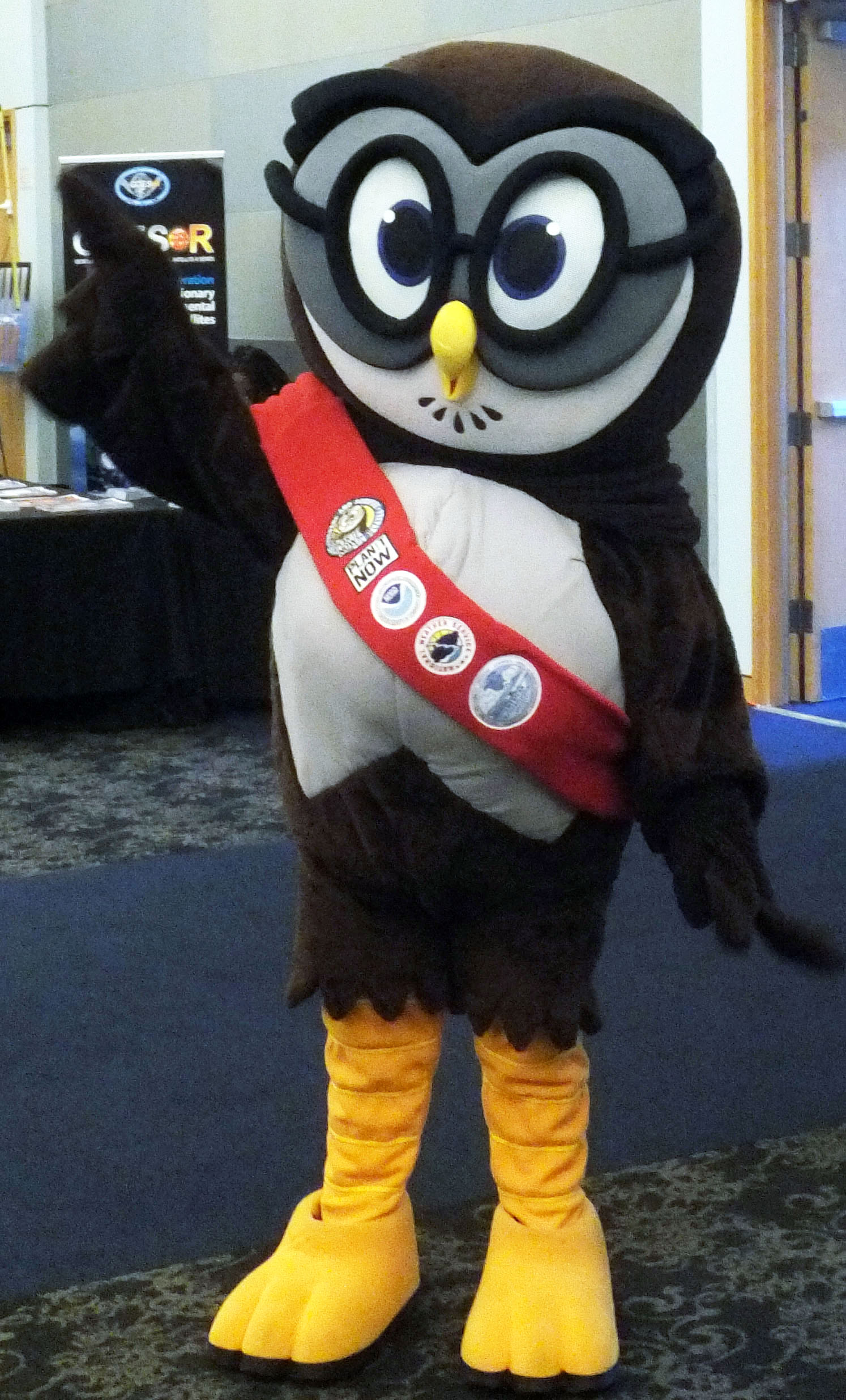
Thanks to special guest star Owlie (Xochilt Corona) and assistant Ashley Santisteven for promoting the Young Meteorologist Program during multiple appearances at Satellites & Education Conference XXXII. Concieved by the National Weather Service, developed and maintained by PLAN!T NOW, the Young Meteorologist Program is an on-line game teaching disaster preparedness and survival to children of middle-school age (although the game appeals to "children" of all ages).
Gamers follow Owlie Skywarn on a Severe Weather Preparedness Adventure as he works with experts to learn about hurricanes, thunderstorms and lightning, floods and flash floods, tornados, and winter storms, how to prepare for them and how to survive in them. This educational, animated game includes checks for understanding, downloadable resources, and a printable Young Meteorologist certificate for those completing all five modules. In addition, the SEA Lesson Plan Library offers a lesson plan using the Young Meteorologist Program with students grades 4-12 and keyed to Next Generation Science Standards.
Owlie apperared courtesy of Donna Lee, Executive Director of PLAN!T NOW.
Conference Staff
Many thanks to the tireless workers who helped prepare for and deliver a successful conference. SEA Conference Coordinator Paula Arvedson has oft been quoted saying, "These gracious volunteers are largely responsible for the success and longevity of this conference." The conference staff was visible during the conference and worked tirelessly behind the scenes. Special thanks to Volunteer Coordinator Paul London for organizing the staff composed of teachers or teachers-in-training from the Charter College of Education at Cal State LA and other volunteers. He was ably assisted by Ashley Santisteven in charge of registration and Erica Martinez helping with photography.
Satellite Educators Association
The Satellite Educators Association (SEA), producer of the conference, was founded in 1989 in response to an overwhelmingly positive turn out for the first Satellites & Education Conference at West Chester University in Pennsylvania. SEA is a non profit 501(c)(3), professional organization of educators and others who want to enhance the education environment to excite students about science, technology, engineering, and math (STEM) through space-based technology - satellites and satellite remote-sensing data. Association activities include professional development for teachers, especially the annual Satellites & Education Conference, the international Multinational Youth Studying Practical Applications of Climatic Events (M.Y. S.P.A.C.E.) research collaborative for K-12 students, the online SEA Lesson Plan Library, and the almost-monthly SEA Newsletter online. SEA members have assisted in full or supplemental curriculum development to meet the needs of specific state standards, learning groups, and classrooms on request; promoted public outreach; and consulted with aerospace businesses in meeting their educational outreach requirements. The Conference and the M.Y. S.P.A.C.E. Program are supported by SEA members, NOAA (especially NESDIS and NWS), NASA, and the Charter College of Education at California State University, Los Angeles.
For more about this and other conferences and activities of the Satellite Educators Association, visit http://SatEd.org.
Photo Credits: Satellite Educators Association
The Impact of Apollo 11 Mission on Education
by
Helen Martin
These are the personal recollections of Helen Martin, founder of the Satellites & Education Conference and the Satellite Educators Association. With permission, the memoir was shared with attendees of Satellites & Education Conference XXXII on Friday, August 1, 2019, by Dr. Paula Arvedson during a panel discussion on the Imapcts of Apollo 11 on Education.
Day of the Launch to the Moon
And so, it was 50 years ago - the Apollo 11 Mission to the Moon began! The Navy had flown our group of 200 teachers from the Philadelphia area that had been selected and completed an intensive 2-week series of courses on space technology taught by outstanding NASA instructors. For those seminars, I had driven nearly 2 hours one way every day for 2 weeks but it was so worth it! Then again, I was 50 years younger in those days! I learned so much so quickly during those seminars. We were flown to Florida for the launch of Apollo 11. My feet were getting wet in the Indian River as our group had arrived first the night before and we had tried to sleep a bit on that grassy bit of sand behind the McDonalds along the Indian River and directly across from the launch site. We were told that we were about 10 miles away and that no one was allowed much closer. I do not know if any of us slept more than perhaps 10 minutes on that beach as we were all so excited and full of anticipation waiting for the launch. From about 8 AM, our little viewing area was filled with personal radios blaring the information before and including the countdown. We all counted down together on that beach of the Indian River - all 200 plus perhaps another 500 who were crowded behind us on that little tiny spot of beach across the Indian River from the launch. At 9:32 AM EST the Saturn V booster rocket ignited. We were all so elated. The excitement in that crowd was quite amazing and all of us together were cheering those 3 men on. We headed to our busses and then very slowly through one of the worst traffic jams I have ever seen on roads never intended for such traffic, we made our way back to our hotel in Daytona Beach. We got cleaned up, had a walk on the beach and the next day headed for our Navy cargo plane for the flight home. It was an experience I have never forgotten. I had no idea of the dangers and the problems that might arise during those days. I only felt sheer excitement that WE were going to the Moon. I used the term "we" because everyone on Earth felt as if each was a critical part of that mission. Upon his return, Neil Armstrong was concerned that he was getting too much recognition in the days and months afterwards and wanted the credit to go to the 400,000 men and women who had made the mission possible.
Day of the Moon Landing
Fifty years ago July 21, I had returned home from seeing the launch of the Apollo 11 Mission to the Moon, my brother and I were in front of the small black and white TV screen in our living room watching or more realistically hearing what Neil Armstrong said when the Lunar Landing Module, Eagle, landed on the Moon, "The Eagle has landed." Then I heard someone from Houston Manned Space Flight Center say something like, "You've got a bunch of guys down here about to turn blue." With all my seminars and prelaunch briefings, I did not understand the import of that comment until years later. It seems that the Lunar Module was headed for the slope of a crater with too steep a grade to launch the return from and so Armstrong and Aldrin turned off the automatic landing computer and using the knowledge they had both gained as test pilots and they flew the last bit of the flight manually and literally only had about 8 seconds of fuel left when they landed! That landing was a real concern as was the walking on the Moon by man because the Earth-bound scientists had seriously believed the Moon might have a layer of dust on its surface as deep as perhaps 10 miles from eons of meteors crashing into it. The couple of inches of dust was a huge relief to all who knew. The Lunar Module had landed but it was not for a couple of hours until Astronauts Armstrong and Aldrin exited the module and went down the ladder to walk on the Moon. Man set foot on the Moon! The picture was so faint and fuzzy that we could hardly determine what we were looking at as we tried to watch Armstrong and then a bit later Aldrin descended the ladder. We clearly heard Astronaut Neil Armstrong say, "That's one small step for man and one giant leap for mankind" even though we could hardly see it.
Impact of the Apollo 11 Mission on Education
It is difficult to image that the Apollo 11 Mission did not impact education. Every teacher and every student who saw it in person or on TV was watching it with spellbinding interest. Hardly any eye blinked while watching the launch, the Moon landing and the Moonwalk. Students were interested and teachers were quickly learning new information and adapting aspects of the Apollo Mission for their individual classes. Publications for teachers from NASA on the Moon landing increased dramatically and classrooms became filled with posters and images of the astronauts, the launch, the landing, the Moon walks, the experiments left on the Moon, and drawings explaining the orbits of the craft and the information which the Moon experiments hoped to gain. Teaching ideas and insights began to flow from educators into classrooms and into teaching journals for students of all ages and in all subject areas.
For me personally, seeing the Apollo 11 sparked my imagination, which has lasted a lifetime. Initially, the Apollo 11 launch caused me to write a major paper for my Masters degree on the history and development of rocket technology. Also, I wanted to see another launch and then another. The most valuable aspects of each launch were not just seeing the launches themselves but attending various prelaunch briefings. The seed of my interest was nurtured and it began to grow exponentially. I immediately purchased all books and 35 MM slides of images of the Earth from space, that I could find and I began using them in my classroom. While attending an NSTA national convention, in 1973, I obtained a booklet from the amateur radio booth, which told of a teacher in Perth, Scotland who was using satellite technology with a small group of his students. Then in the early 1980s, I read an article in The Science Teacher written by Joe Summers, a teacher in Chambersburg, Pennsylvania who was obtaining images directly from satellites with his students. I was excited because not only was a teacher using satellite images with students but he was also teaching at a school about three and a half hours from my school. I obtained permission from my principal to visit his school and see what he was doing during a professional day at my school. As Joe and his students showed me their satellite image receiving set up, I knew I wanted to do it with my students. However, there were a number of roadblocks to doing so. I did not have the technical knowledge, which Joe had for amateur radio usage, building such a system and for understanding how to use it in my classroom. Joe Summers was using the technology with a small group of select students who were interested and I had the cross section of the student population with whom I wanted to use it. There was no money available for it in my science budget. I mentioned the idea to my students and they wanted to begin immediately but I could not see how we could confront the roadblocks.
I asked for a meeting with my principal one Monday in November 1983. I explained that I wanted permission to build the station and explained that I was going to form committees of students to carry it out. I explained how I thought the Earth and Space Science course I was teaching could be taught using satellite technology and that each section of the course namely geology, astronomy, meteorology and oceanography could be taught using satellites and satellite data. He gave me permission to try it but he said several times, he could not give me any money to do it. So, I formed committees of students to carry out our mission of receiving images from weather satellites and using such data within our stated curriculum. By the end of May in 1984, we were receiving images directly from satellites owned by both the United States and the USSR, as it was known then.
Student and teacher excitement grew with each new step of learning and my students were invited to present our work at an international conference of users of satellite data in Baltimore. I saw my high school students mature as they proudly presented their work to adults from around the world in government and industry. I also saw adults seriously interested in the work of the students and that inspired all of us.
From that international conference grew the idea of the first international conference of students, satellite educators, government representatives and related industries in 1986. From the conference grew the idea of a Satellite Educators Association and from that grew the idea for the booklet, A Day in the Life of Satellites, a collection of satellite images from a number of schools from Washington state, California, the mid-West, the East Coast to England, Wales and South Africa.
Upon reflection today, it is difficult to realize that all of that happened before computers, FAX machines and the Internet were all commonplace in school classrooms.
No space mission captured the imagination of everyone around the world as the Apollo 11 mission. The Apollo 11 Mission sparked a lasting interest and curiosity to learn more about science and mathematics and lead to the exponential growth of knowledge in all fields for students and teachers.